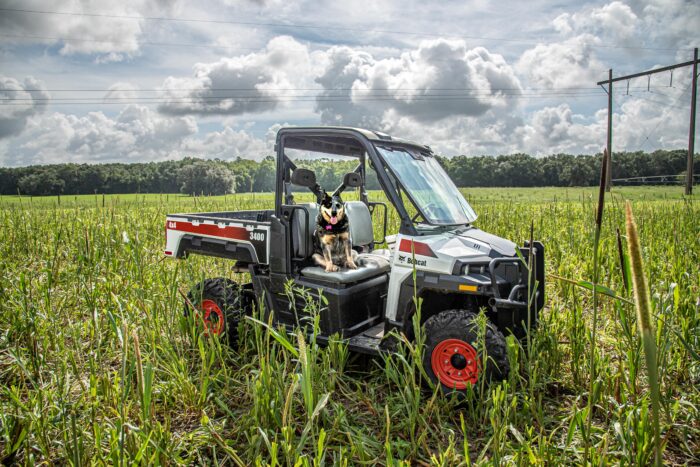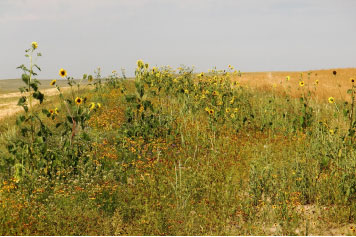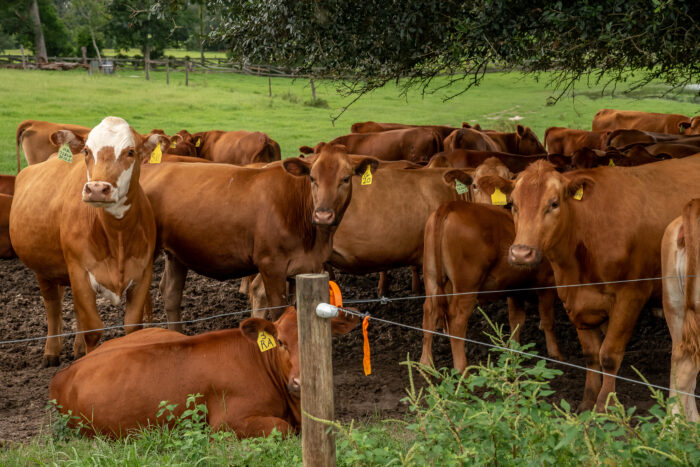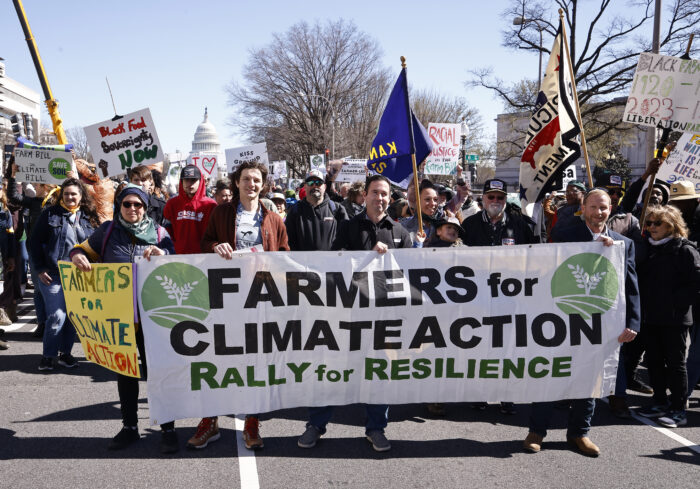This is the second post in a two-part blog series highlighting stories of farmers who have used practices from the Climate-Smart Agriculture and Forestry practice list to build climate resilience and mitigation solutions. This week’s post shares stories of...
 After heavy grazing, a mixed summer forage is still building soil. The mix includes sorghum-sudangrass, sunn hemp, cowpeas, and millet. Photo credit: Cathy Day
After heavy grazing, a mixed summer forage is still building soil. The mix includes sorghum-sudangrass, sunn hemp, cowpeas, and millet. Photo credit: Cathy DayEditor’s Note: This post is the second in a two-part series. Last week’s post highlighted the stories of farmers who have used practices from the Climate-Smart Agriculture and Forestry practice list to build climate resilience and mitigation solutions. This week’s post adds stories created and gathered by National Sustainable Agriculture Coalition (NSAC) members around the country. They have gathered more than two dozen additional stories of how farmers are preparing for and responding to climate change. Some of the links below include multiple stories, so we encourage you to explore them all. The full list of contributors is at the end of this post.
The Inflation Reduction Act (IRA) provided an historic investment of nearly $20 billion in agricultural conservation funding focused specifically on climate change. Despite the popularity of and demand for these funds among farmers, some members of Congress–including House Agriculture Committee Chairman Glenn Thompson–have proposed raiding them, which would ultimately leave farmers without the tools necessary to build resilience and their livelihoods.
As negotiations around the next farm bill continue, farmers and hundreds of stakeholders want to make sure that funding for climate-friendly practices is protected and remains in conservation programs with a climate focus. The farmer stories gathered below highlight the climate challenges and solutions of a diverse set of farmers. They also underscore the vital role that IRA funding can and should continue to play.
 Conservation buffer in bloom at Vilicus Farms. Photo credit: Vilicus Farms
Conservation buffer in bloom at Vilicus Farms. Photo credit: Vilicus FarmsFarmers Are Coping with Severe Weather
Many of the stories gathered by NSAC members highlight the climate impacts to which farmers are responding. For example, at Eckert’s Farm in Belleville, MO, Chris Eckert has seen extreme freezes killing off parts of his peach orchard. They were lucky enough to have crop insurance to cover their losses, but many farmers are not so lucky.
Other means of managing weather risk are, like crop insurance premiums, funded by the federal government. For example, the Natural Resources Conservation Service (NRCS) Environmental Quality Incentives Program (EQIP) provides funding for high tunnels that have helped farmers in Kansas City deal with unexpected and volatile weather.
Adaptation to Weather Includes Multiple Climate-Smart (and Water-Smart) Practices
Farmers’ experiences with extreme weather often include impacts like heavy downpours and droughts. Joseph Fischer, of Fischer Farms in St. Anthony, IN, has substantially reduced the impacts of downpours on his farm by adopting managed rotational grazing and improving his pastures. Not only does his cattle system capture carbon, but he also improves water infiltration and water holding capacity in his soils.
While farmers like Fischer are avid proponents of the need to address greenhouse gas emissions, others may be less certain about that need. Lee Siler nonetheless advocates for high-quality conservation practices and employs them on his farm. He does not till his farm, and he plants extensive cover crops. Further, because he cares so much about the water quality impacts of his work, his farm monitors the phosphorus levels in his run-off and employs water management techniques that limit what little erosion may still occur despite his other practices.
At Foxtrot Farm, on the other hand, Abby Ferla is explicit about the need to address climate change. She has experienced an increase in severe storms and heavier snows that have caused high rates of erosion and flooding on her farm. Consequently, she has been mindful to adopt practices that help her mitigate those impacts. She contours her beds to hold soil in place, and she does not till. To help with the crops in most need of protection, she also employs a high tunnel. She has worked to select new crops that are more climate resilient, including the elderberries she recently planted.
Hameed and Ayo Bellow have seen weather flip from heavily wet to very dry from one year to the next. So, at Agric Organics, they mulch for moisture retention and they also have obtained a high tunnel to protect some of their crops. As a smaller farm, they have struggled with the reimbursement model of NRCS, but have found a path to using the funding, nonetheless.
In Byron, MN, Martin Larsen has also seen much heavier rainfall than in the past. As he transitions toward a farm that is more resilient, he has adopted a no-till system and a much more well-rounded rotation that includes small grains. The grains help reduce his risk during drier periods, and maintain his soil during wet periods.
Richard and Diana Sloan, in Buchanan County, IA, have also incorporated small grains into their corn and soybean rotations, functioning in part as cover crops. Further, they have added nearly five acres of prairie strips. Both practices reduce their climate risk while increasing the farm’s ability to absorb carbon.
 Rotationally grazed cattle behind an electric fence. Photo credit: Cathy Day
Rotationally grazed cattle behind an electric fence. Photo credit: Cathy DayMeg Funfar Nielsen, of Glenville, MN, also relies on cover crops. She has shifted her farm away from the corn and soybean rotation so common in her area, and is instead employing pasture and grazing systems. To reduce the impacts of high winds, she has been able to use the Conservation Reserve Program to help her implement windbreaks.
Efforts to incorporate more trees in farming are gaining momentum. They provide important resilience in droughts and floods, and they sequester carbon. Rick Hartlieb, of Castanea Farms in Pennsylvania, has used local and state grant resources to help him plant acres of chestnuts and to shift his farm toward silvopasture. Despite experiencing a spring with no rain, he has persisted and is increasingly finding markets for his nuts.
Droughts and floods are a central part of the climate story for Wendy Johnson in Iowa, too. She has invested heavily in making her farm more resilient to climate change and reducing its environmental impacts. From a corn and soybean farm, she has developed rotational sheep and cattle grazing, silvopasture, a riparian buffer, perennial (Kernza) grain fields, pollinator habitat, and a micro orchard. In all, she now maintains 130 acres of perennial crops and, as a consequence of that and related practices, she has no phosphorus runoff from the farm and little nitrate loss. She believes that federal funding is key to ensuring that more farmers can adopt such practices.
Conservation Funding Is Key to Better Practices
Hannah Bernhardt maintains that without conservation funds, she would probably have burnt out on farming already. She converted degraded land into a highly diversified grass farm where she grazes sheep. To reduce Bernhardt’s workload, she has obtained NRCS funding for conservation practices like those funded by the IRA, such as water lines and fences. By eliminating her need to haul water, the funding has saved her hours every day. The bonus: increased climate resilience and carbon sequestration capacity.
Another livestock farmer, Bob Vollinger, has also shifted toward grazing practices. Long a hay farm, Vollinger Farms, in Florence, NH, was seeing his hay cuttings severely reduced by drought. Vollinger chose to add beef into his system, and NRCS shared the costs of removing invasive species like oriental bittersweet and multiflora rose. He began to intensively manage his grazing and, like with Bernhardt, NRCS helped with fencing and watering systems.
At Sawyer Farms, Lincoln Fishman and Hillary Costa have also had help from NRCS to remove invasive species. At their farm in Worthington, NH, they view climate as a major threat, so they are taking strong measures to adapt. One of their most important moves has been to plant a clover cover/intercrop throughout their systems and to eliminate tillage. Since the practice is relatively untested in the area, they have obtained a Sustainable Agriculture Research and Education grant to investigate the best way to carry it out.
 A clover crop interseeded into pasture. Photo Credit: Cathy Day
A clover crop interseeded into pasture. Photo Credit: Cathy DayOn the West Coast, the climate impacts can be especially challenging. Teresa Kurtak, in Pescadero, CA, once had to be evacuated for eight days due to climate-change-exacerbated wildfire. She, too, has experienced both drought and flood. At Fifth Crow Farm, she has obtained NRCS funding to plant native hedgerows which she intends, “to provide habitat and travel corridors for beneficial insects and pollinators.” She also employs cover crops, composting, and reduced tillage.
The eponymous brothers of My Brothers’ Farm in Oregon also see habitat provision as part of their role as farmers. Austin, Ben, and Taylor Larson have moved from farming ryegrass to implementing a diversified orchard; riparian forest; silvopasture with pigs, oaks, and hazelnuts; pastured bison; and native plants. Although they have experienced challenges in finding ways to process all their products, EQIP has supported them well in their conservation practices, including cost share for hedgerows, efficient irrigation, water pipelines, and troughs.
Bruce and Connie Carney also have received support for their managed rotational grazing system. Through the Conservation Stewardship Program (CSP), Carney Family Farms in Iowa has received funding for watering, waterways, field buffers, and no-till practices. The farm is profiled along with other conservation-minded farmers here.
A move toward rotational grazing also inspired John Bell’s application for support from EQIP. At Elmwood Stock Farm in Kentucky, he was practicing crop-livestock integration and extending his rotations. His fields are managed with multi-species grazing for four or five years to help them rebuild their fertility between other crops. His EQIP cost-share helped him build up his cover crop system and diversify his pastures.
Ryan Vogel, in Iowa, credits CSP with enabling some of his practices. “I wouldn’t have ever done the cover crops if I didn’t get cost share through CSP,” he said. When he obtained his contract, he already had a no-till system in place. CSP allowed him to add cover crops, soil testing, and nutrient management to his farm.
Conclusion
Many of the farmers featured above have successfully obtained NRCS funding to help them adapt to climate change or mitigate their emissions. However, some in the list above and many others besides have not been able to obtain EQIP and CSP funding. In 2022, only 24.8 percent of those who applied for CSP succeeded in obtaining contracts. As Michael Happ of the Institute for Agriculture and Trade Policy notes, with extreme weather conditions presenting ever-greater challenges, the funds in the IRA are vital for ensuring that farmers can access the assistance they need to implement practices that make their farms more resilient and part of the climate solution.
Congress should ensure that the agricultural conservation funds in the Inflation Reduction Act continue to support the USDA conservation programs–not just EQIP and CSP, but also the Regional Conservation Partnership Program and Agricultural Conservation Easement Program – and reject any proposals that undermine farmers by shifting these funds elsewhere. With climate challenges rising year by year, farmers need that funding to continue to support their livelihoods as well as efforts to mitigate and adapt to climate change.
Appreciation
With thanks to all of the NSAC member (and ally) staffers who contributed stories through one means or another. We appreciate your work!
Ashley Chesser (Wild Farm Alliance)
Courtney Hattaway (Cultivate KC)
Sarah Hunt (Climate Land Leaders)
Wendy Johnson (Climate Land Leaders)
Megan Kemple (Oregon Climate and Agriculture Network)
Jacob Nelson (Community Involved in Supporting Agriculture)
Sara Nicholas (PASA Sustainable Agriculture)
Melissa Vatterott (Missouri Coalition for the Environment)
Elizabeth Wilhelm (Practical Farmers of Iowa)
+
Green Lands Blue Waters
Organic Farming Research Foundation
Institute for Agriculture and Trade Policy
Center for Rural Affairs
Farm Aid
The post Farmer Conservation Stories: Why Inflation Reduction Act Funding Must Remain Focused on Climate Change appeared first on National Sustainable Agriculture Coalition.










